Key Brand Metrics to Track To Evaluate Performance
Want to assess your brand health and performance? These are the brand metrics you should track.

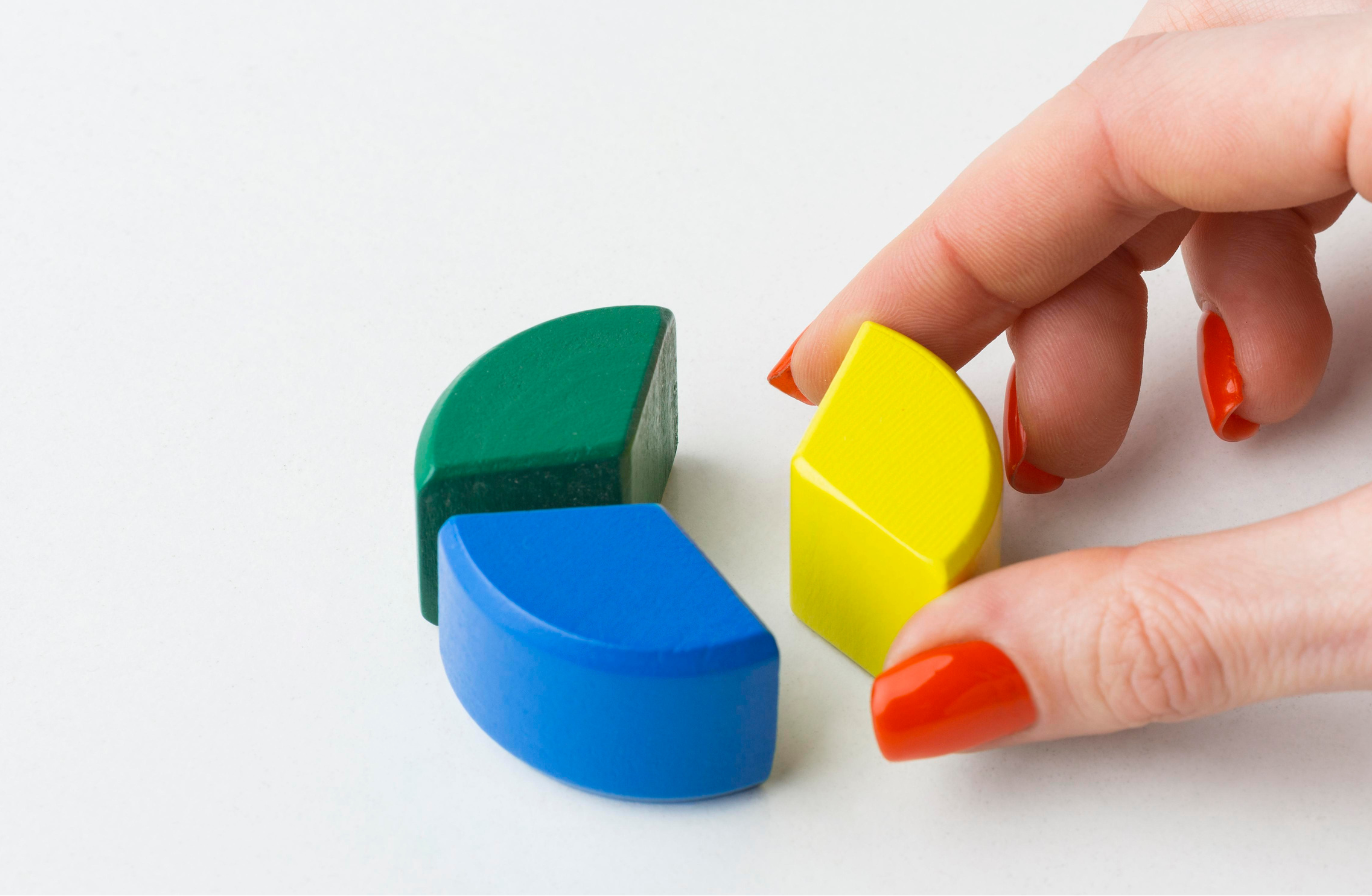
Creating a strong brand is powerful. Think about how certain brand names have become synonymous with their product, like Kleenex, Band-Aid, and Tupperware. Those companies have incredible brand strength, and it’s all down to paying attention to the right brand metrics.
By tracking your brand metrics, you can understand how people feel about your brand, your position in the market, and so much more. Therefore, tracking your brand’s marketing metrics is key to building a solid customer base—and retaining it.
Read on to learn more about what brand metrics are, why they’re important, plus the essential brand metrics to track.
Key takeaways
-
Reach measures unique users who saw your content while impressions count total views including repeats - both matter for understanding brand exposure and recall
-
Share of Voice (SOV) shows your brand’s visibility compared to competitors across all channels - positive SOV matters more than raw mention volume
-
Customer Lifetime Value (CLV) is the main brand health metric - strong brands lead to higher retention, more frequent purchases, and willingness to pay premium prices
-
Net Promoter Score (NPS) measures loyalty with one question about recommending your brand - scores above +50 are excellent and indicate strong brand advocacy
-
Social mentions should be analyzed for both quantity and quality - 500 positive mentions from respected voices can be more valuable than 10,000 negative ones
-
Brand sentiment analysis goes beyond positive/negative to include specific emotions, intent detection, and topic-level insights about what’s driving customer feelings
-
Use the SMART framework when choosing metrics: Strategic, Market-driven, Actionable, Repeatable, and focused on customer Touchpoints
-
Always benchmark against competitors - you can’t measure brand success in isolation, and comparative data reveals growth opportunities
What are brand metrics?
Brand metrics are quantifiable data sets that give you insights into how your brand is performing. The metrics data provides details on things like brand perception, campaign performance, and how effective your marketing strategy is.
The brand metrics you pay the most attention to will correlate with your specific business objectives. For example, newer companies looking to grow their initial customer base might look more closely at brand KPIs like brand awareness, while a larger business looking to make more sales might pay attention to brand equity.
And a company resolving a recent PR crisis would be more interested in brand perception than anything else.
It’s important to track the right brand metrics so that you know where you stand with your target audience. Having this knowledge is key to growing your business.
Brand metrics vs KPIs
Before I go further, it’s important to highlight the difference between brand metrics and brand KPIs. Brand metrics are quantitative data points that track how your brand performs in the market, covering aspects like awareness, sentiment, loyalty, engagement, satisfaction, and retention.
Brand KPIs (Key Performance Indicators), on the other hand, are specific, measurable metrics chosen to track progress towards your brand goals, such as improving awareness, increasing retention, or growing advocacy. KPIs should be relevant, actionable, and consistently trackable.
Why are brand metrics important to track?
Before we dive into the brand metrics you might want to add to your monthly reports, let’s talk about why tracking this data is so important. There are five key reasons why.
- Know how people feel about your brand. Having the inside look into your audience’s feelings towards your brand can help you improve your positioning and run the right campaigns.
- Retain customers. Strong branding improves customer loyalty, so tracking your brand metrics can help you keep customers coming back.
- Understand your brand’s position in the market compared with competitors. Get a clear idea of how your brand is faring against competitors so you know if you need to improve your standing.
- Increase revenue. Better branding means more visibility. More visibility inevitably leads to more customers and more revenue.
- Catch problems early. Monitoring your brand and its key metrics will give you a quick heads-up if you’re facing some kind of brand reputation crisis, so you can easily handle it.
The bottom line is this: tracking your brand metrics gives you important insights that can help you make better business decisions.
Brand awareness metrics: measuring your brand’s visibility
Question to answer: “Are people discovering and recognizing my brand?”
Brand awareness refers to how familiar your target audience is with your brand. Can they recognize your logo or brand name? Can they recall your brand when thinking of your industry or product?
The more aware your target market is about your brand, the more likely they are to lean on your products when the need for them arises. But more than that, the more brand awareness you build, the more trust your customers will have in you.
Plus, as you become more and more recognizable in your industry, it becomes harder for your competitors to keep up with you.
But how do you measure brand awareness? There are a few ways to keep track of how well people know about your brand.
1. Reach: measuring your brand’s total audience
Social media reach refers to the total number of unique users who have seen your content. It’s a foundational metric because it directly reflects your brand’s ability to cover your total addressable market (TAM) — the larger the reach, the more people are aware of your brand, products, or services.
When your content consistently reaches a wide audience, it drives brand visibility, fuels top-of-funnel growth, and lays the groundwork for engagement, conversions, and loyalty. Whether you’re launching a new product or scaling an established one, your ability to grow hinges on how effectively you can reach more of the right people — ahead of your competitors.
To calculate reach, you typically use native analytics from each platform, or third-party social media analytics platforms such as Socialinsider.
But knowing your own reach is only the beginning. What matters more is understanding how your reach stacks up against your competitors and industry peers. That’s where competitive benchmarking comes in.
With tools like Socialinsider, you can:
- Compare your brand’s reach against direct competitors on key platforms.
- Measure share of reach: Are they reaching a larger percentage of your shared audience (total addressable market)?
- Identify which content types or formats drive the highest reach across industries.
- Track how your reach evolves over time — and whether competitors are outpacing your growth.
This competitive lens helps you identify opportunities to optimize, target new segments of your TAM, and ultimately, capture more market share through smarter social strategies.
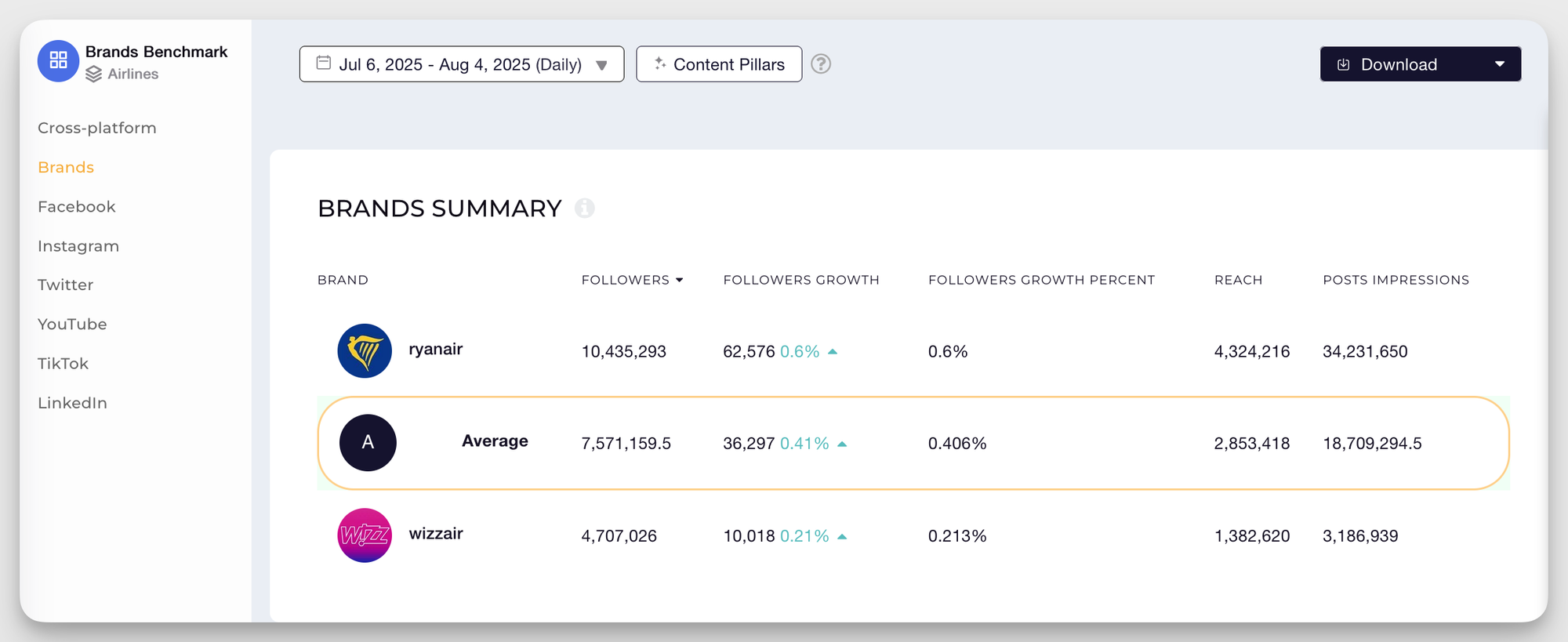
2. Impressions: understanding brand exposure frequency
Although often used interchangeably, reach and impressions are distinct metrics:
- Reach = the number of unique users who saw your content.
- Impressions = the total number of times your content was displayed — including repeat views by the same user.
Example:
If 1,000 people each see your post twice, your reach is 1,000, but your impressions are 2,000.
Impressions reveal how often your audience is exposed to your brand content. Reach tells you how far your content is spreading. Because people may see your content more than once, impressions tend to be higher than reach.
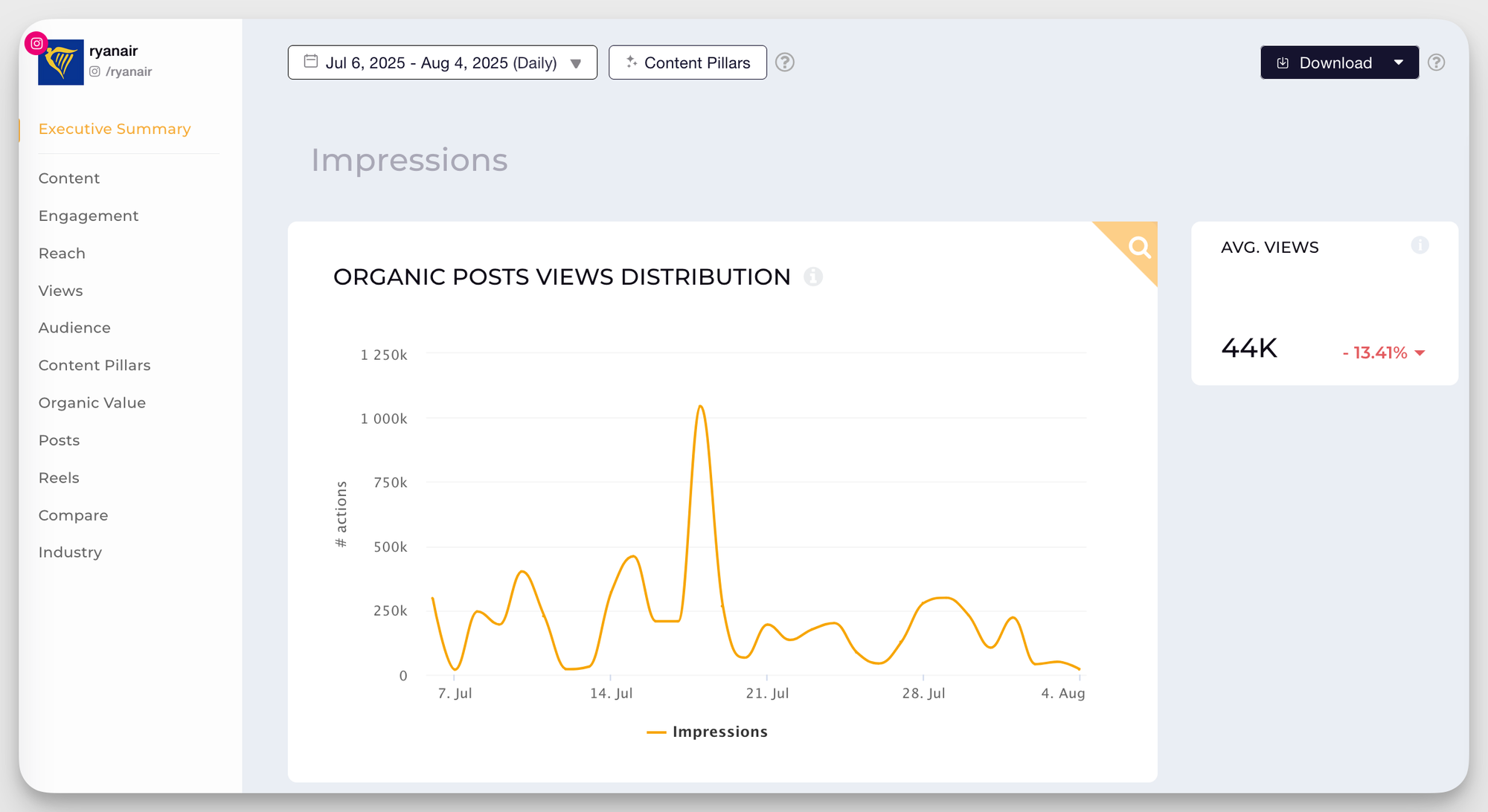
Why impression frequency impacts brand recall
Impression frequency refers to how many times, on average, a single user sees your content. This is critical for brand awareness and recall.
Psychologically, we’re more likely to remember a message when we see it repeatedly. In marketing, this is known as the “effective frequency” — the number of exposures required before a message sticks.
- If your frequency is too low (e.g., 1–2 impressions per user), your brand may be easily forgotten.
- If it’s too high, it can lead to fatigue or even annoyance — especially if the content isn’t engaging.
The sweet spot varies by platform and audience, but many marketers aim for 3–7 impressions per user to maximize recall without oversaturation.
Top-of-mind awareness: Put out customer surveys to help determine if your brand is the first one that comes to mind in its category. Ask questions like:
- What brand(s) come to mind when you think of [your industry]?
- When did you first learn about our brand?
- Over the past 12 months, how often have you heard about our brand?
- Which product are you most familiar with from our brand?
3. Share of Voice (SOV): your competitive visibility position
Share of Voice (SOV) measures how much visibility your brand has in the market compared to competitors — across channels like social media, digital ads, PR, and even traditional media.
It’s often expressed as a percentage of total industry conversations or impressions. For example, if your brand accounts for 25% of all social mentions in your industry, your SOV is 25%.
A high SOV indicates brand dominance. The greater your SOV relative to your market share, the more you’re punching above your weight — and the more likely you are to capture future market share.
Why positive share matters more than total mentions
Not all mentions are created equal, though. A brand could dominate in total mentions but be negatively perceived — due to backlash, PR crises, or negative reviews.
That’s why it’s important to distinguish between:
- Total SOV = All brand mentions
- Positive SOV = Mentions with favorable sentiment
Positive SOV reflects brand health and trust, which influence consumer decisions more than raw volume. It tells you not only how loud your brand is, but whether people like what they hear.
Sentiment analysis platforms can help filter mentions by tone — so you can focus on quality over quantity.
Personally, I use quantitative and qualitative data to measure the SOV, awareness, sentiment, etc. It’s not enough to just ask if people see us at this point in our industry; we need to instead look deeper at the metrics to understand if people are remembering our brand.” - Jessica Mann, Brand Growth Strategist
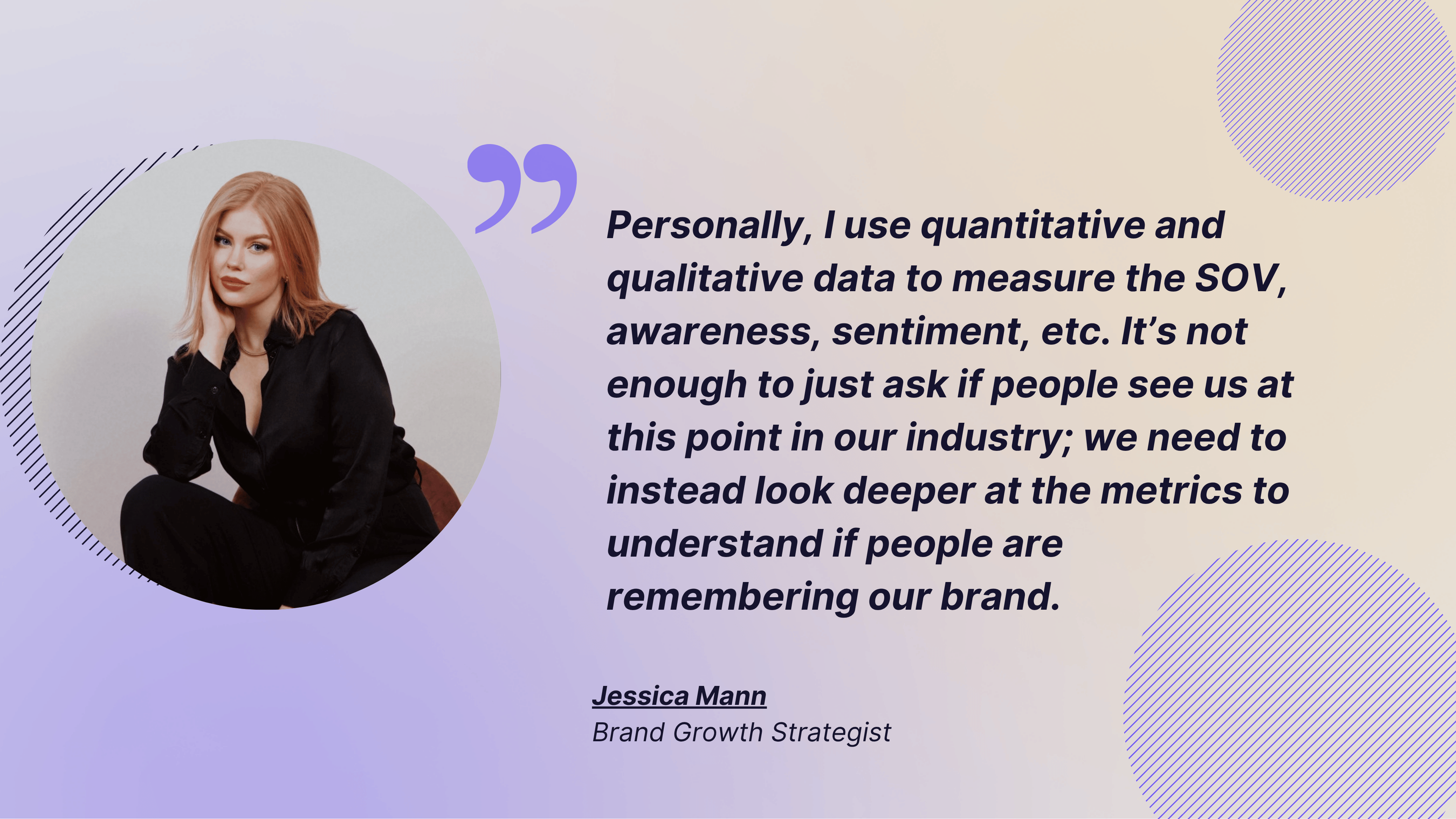
Calculating SOV across digital and traditional channels
To calculate SOV, you need to define your scope (e.g., social media, paid ads, PR) and track all brand mentions — yours and your competitors’ — over a set period.
Basic formula: SOV (%) = (Your brand’s mentions or impressions / Total mentions or impressions in your industry) x 100
Apply this to:
- Social media: track branded mentions, hashtags, tags
- Paid search/display: compare ad impressions or spend
- PR coverage: analyze how often your brand is featured in the media
- Traditional media: use media monitoring services to track mentions on TV, radio, or print
Cross-channel SOV gives you a holistic view of brand visibility across the full customer journey.
Using SOV to identify growth gaps
Analyzing SOV alongside market share reveals growth opportunities. If your SOV is higher than your current market share, you’re positioned to gain traction. If it’s lower, you may be losing mindshare to competitors.
Tracking SOV over time helps you:
- Spot underperforming channels where competitors dominate
- Find untapped audiences or topics you should own
- Set realistic goals for content, ad campaigns, or influencer activations
In short, SOV is a strategic compass for identifying where to show up louder, smarter, and more meaningfully.
4. Search Volume: capturing digital brand interest
Search volume reflects how often a keyword or phrase is searched within a specific timeframe and location, typically measured monthly. When applied to your brand name, it becomes a direct indicator of brand demand.
Rising branded search volume means more people are actively looking for your business, suggesting:
- Increased awareness from campaigns, social content, or word-of-mouth
- A stronger position in consumers’ minds
- Higher intent to engage, purchase, or learn more
Think of branded search as a real-time pulse of your brand’s visibility and desirability in the market.
To fully understand your brand’s performance in search, it’s crucial to separate branded keywords (terms that include your brand name, e.g., “Socialinsider analytics tool”) from non-branded keywords (general industry or product terms, e.g., “best social media analytics tool”).
Why this matters:
- Branded searches = indicators of brand strength and loyalty
- Non-branded searches = opportunities to capture new users who haven’t yet chosen a brand
Tracking both helps you:
- Assess the impact of brand awareness campaigns (look for branded search spikes)
- Optimize for SEO and content strategy to grow discoverability in broader, non-branded categories
Tools like Google Search Console, Ahrefs, and SEMRush can help you differentiate and monitor both keyword types.
Seasonal and trend analysis for search metrics
Keep in mind that search volume isn’t static; it often follows seasonal cycles and broader market trends.
By analyzing historical search data, you can:
- Predict peak periods of demand (e.g., health supplements spike in January, B2B tools in Q4)
- Plan marketing and content calendars accordingly
- Capitalize on emerging trends before competitors (e.g., rising interest in “AI social analytics”)
Use tools like Google Trends or Keyword Planner to spot:
- Search spikes tied to events, product launches, or news cycles
- Declining interest in outdated terms or features
- Regional differences in search behavior
Tracking search volume trends helps you stay ahead of the curve and align your strategy with what your audience actually wants — when they want it.
5. Website Traffic: converting awareness to action
Website traffic isn’t just about numbers — it’s a signal of how effectively your brand is capturing attention.
When awareness campaigns (like social media pushes, PR features, influencer posts, or digital ads) work, you’ll see:
- Spikes in traffic volume, often aligned with campaign launches or media coverage
- Increases in direct traffic, showing more people remember your brand URL
- Growth in branded search traffic, meaning more users are searching specifically for your brand or products
Monitoring traffic patterns over time helps you assess whether your brand-building efforts are translating into action — not just impressions, but actual visits to your site.
To understand which awareness activities are driving traffic, you should segment traffic sources by campaign and platform. Segmenting traffic this way allows you to:
- Attribute results to specific awareness efforts
- Identify top-performing content types or messaging
- Optimize budget and effort toward the most effective channels
Use attribution models (like first-click or linear) to understand how brand campaigns contribute to visits — even if they don’t lead to immediate conversions. This shows the real value of top-of-funnel efforts and helps justify investment in brand awareness over time.
Brand health metrics: measuring relationship strength
Question to answer: “How strong is our relationship with our customers?”
6. Customer Lifetime Value (CLV): the main brand health metric
Brand strength has a direct influence on Customer Lifetime Value — the total revenue a customer generates throughout their relationship with your brand.
A strong brand leads to:
- Higher customer retention (people stay loyal longer)
- More frequent purchases (greater trust = more engagement)
- Increased willingness to pay (premium perception = higher margins)
- Stronger emotional connection (leading to advocacy and referrals)
In short, the more trusted and recognized your brand is, the more valuable each customer becomes over time.
CLV can be calculated using a simple formula: CLV = (Average Purchase Value) × (Purchase Frequency) × (Customer Lifespan)
For example, if a customer spends $100 per order, buys 4 times a year, and stays with your brand for 5 years, their CLV = $100 × 4 × 5 = $2,000.
You can also use advanced CLV models that incorporate:
- Gross margin (to focus on profit, not revenue)
- Discount rates (to account for time value of money)
- Segmentation (e.g., CLV by channel, cohort, or persona)
Tracking CLV over time helps you measure how brand-building efforts improve long-term customer value, not just short-term conversions.
Using CLV to prioritize brand investments
When CLV increases, it means your brand is building deeper, more profitable customer relationships — and that’s exactly where you should invest.
Use CLV data to:
- Identify high-value segments most influenced by brand loyalty
- Allocate more budget to channels and campaigns that drive long-term value, not just clicks
- Justify branding spend in executive conversations with numbers that prove impact
Instead of focusing purely on short-term ROI, CLV shifts your strategy toward sustainable growth — where brand equity becomes your biggest asset.
7. Net Promoter Score (NPS): loyalty indicator
NPS is a powerful metric because it measures customer loyalty and sentiment with a single question: “How likely are you to recommend our brand to a friend or colleague?”
Customers respond on a scale from 0–10 and are grouped into:
- Promoters (9–10): Loyal fans who fuel word-of-mouth and repeat business
- Passives (7–8): Satisfied but not enthusiastic — vulnerable to competitors
- Detractors (0–6): Unhappy customers who may churn or damage your brand reputation
A high NPS indicates strong brand advocacy, which correlates with:
- Higher retention
- Lower acquisition costs (via referrals)
- Faster, more organic growth
In fact, research shows that companies with higher NPS tend to grow faster than competitors with lower scores.
To calculate NPS: NPS = % of Promoters − % of Detractors
The score ranges from -100 to +100.
- A positive score means you have more promoters than detractors.
- A score above +50 is considered excellent in most industries.
To get deeper insights, segment your NPS by:
- Customer type (e.g., new vs. long-term)
- Product line or service type
- Region or market
- Channel (e.g., online vs. in-person)
Segmenting helps you identify where loyalty is strong and where you’re at risk of churn, enabling more targeted improvements.
Turning detractors into promoters starts with quick, personalized responses and digging into the root causes of dissatisfaction. By actively listening, addressing issues, and following up, brands can not only recover unhappy customers but often build stronger loyalty than before, thanks to the service recovery paradox.
8. Customer Satisfaction (CSAT): measuring experience quality
While both CSAT and NPS measure customer sentiment, they serve different purposes. CSAT focuses on specific interactions or experiences, like a purchase, support call, or product use and captures short-term satisfaction, while NPS measures overall loyalty and long-term brand perception, asking if customers would recommend you.
CSAT isn’t just a feel-good metric; it’s a leading indicator of business performance. Higher satisfaction scores often correlate with:
- Lower churn
- Higher repeat purchase rates
- More positive reviews and referrals
- Better support efficiency (fewer follow-ups or escalations)
To make CSAT actionable:
- Track it alongside retention, revenue, and CLV
- Segment by channel, product line, or agent/team
- Use score trends to identify areas for UX, product, or service improvement
A strong CSAT survey is:
- Timely: Triggered immediately after a key interaction (checkout, support, onboarding, etc.)
- Optional but encouraged: Include an open-text field for deeper feedback (qualitative data is just as valuable)
- Short: Avoid overloading with questions; aim for completion within 30 seconds
- Simple: Ask a clear, single question like “How satisfied were you with your experience today?”, usually rated on a scale from 1 to 5.
Quantitative metrics are your hard numbers and they show brand momentum and behavioural patterns. Yes, they include your typical vanity metrics like SOV, CSAT, customer retention, and more but there are two metrics I believe will have the highest ROI in the next two years which are watch time and audience retention. While often labeled as content metrics, I see them as trust metrics. If people are sticking around, it’s a clear signal your brand is resonating and not just grabbing attention but earning it. - Jessica Mann, Brand Growth Strategist
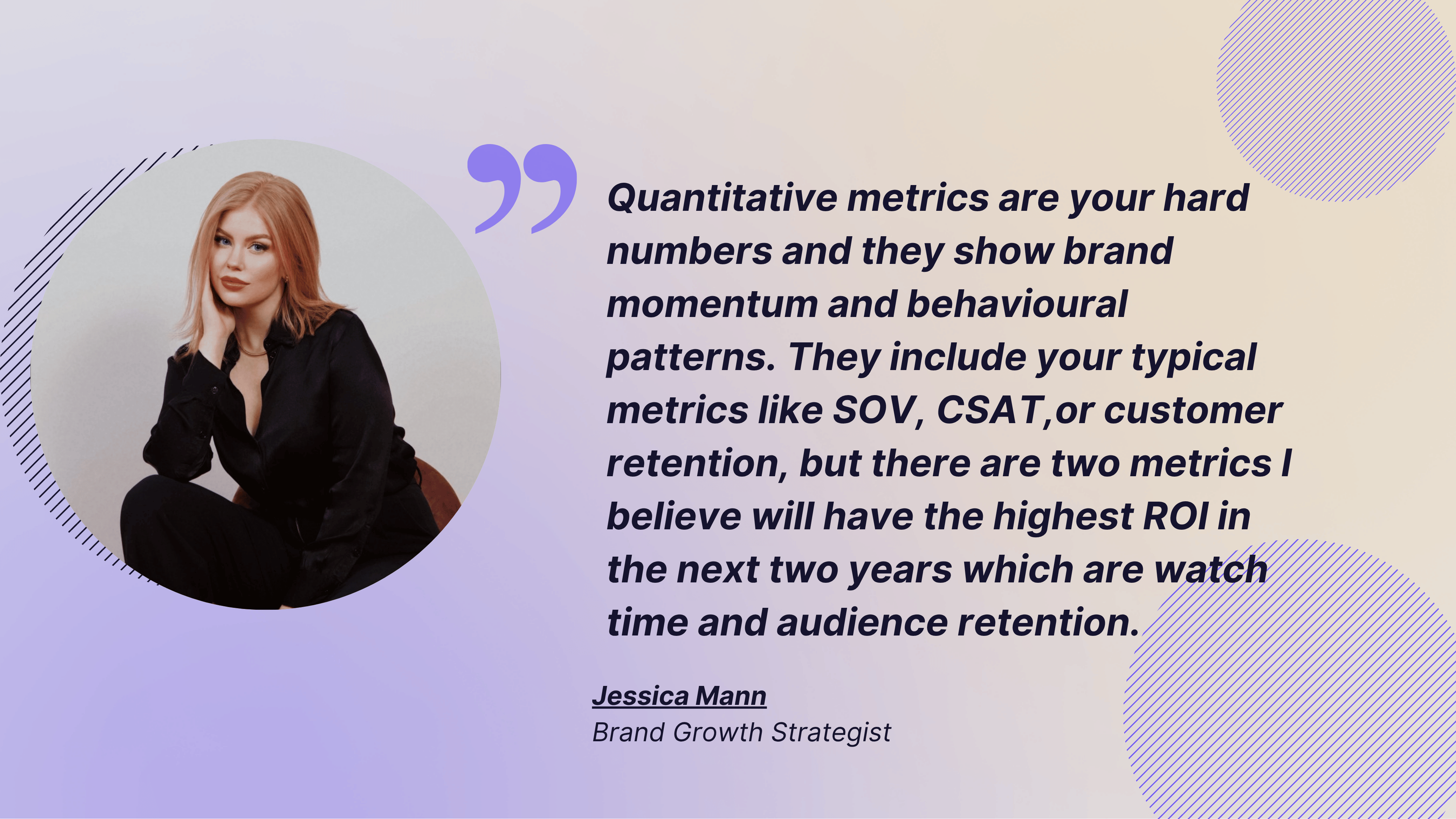
9. Retention Rate: measuring brand loyalty
Retention rate measures the percentage of customers who continue doing business with you over time, making it one of the purest indicators of brand health.
High retention means your brand delivers consistent value, builds trust, and fosters loyalty, all signs of a strong brand. Unlike vanity metrics like impressions or even one-time conversions, retention reflects how well your brand keeps promises and maintains relevance after the first interaction.
Strong retention also leads to:
- Lower customer acquisition costs (since loyal customers stay longer)
- Higher customer lifetime value (CLV)
- Organic growth via referrals and word-of-mouth
When analysing retention, it’s important to do so in cohorts. Cohort analysis groups users based on when they first interacted with your brand (e.g., by signup month, campaign, or channel), then tracks how long they stay active or engaged.
This allows you to:
- Spot patterns in retention over time
- Compare how different campaigns or acquisition channels perform
- Identify drop-off points in the customer journey
For example, if users acquired through a referral program have higher retention than those from paid ads, that tells you where your stickiest audience comes from, and where to invest more.
Retention doesn’t just depend on product performance, though; it’s driven by the overall brand experience.
To boost retention:
- Onboard with value: Help new customers see success quickly
- Stay relevant: Deliver personalized, timely content and offers
- Be consistent: Reinforce your brand’s identity and promise across all touchpoints
- Listen and respond: Use feedback loops (like NPS) to fix pain points before customers churn
- Create emotional connection: Make customers feel seen, heard, and appreciated
Great brands don’t just sell — they build relationships, and retention is the clearest sign those relationships are working.
Brand tracking metrics: monitoring performance over time
Question to answer: “How is my brand performance trending?”
Brand tracking is the ongoing process of measuring and analyzing how your brand is performing over time, in terms of awareness, perception, engagement, and competitive standing.
To spot patterns, trends, and opportunities, you can use the following toolkit:
- Brand awareness over time
- Engagement rate trends
- Competitive benchmarks
This is where social media analytics platforms such as Socialinsider truly shine because not only can you see metrics such as reach, impressions, and engagement rate, but you can also see how they’ve evolved over time (Socialinsider offers up to 12 months of historical data, so you can spot seasonality) and compare them against competitors and industry leaders.
By monitoring brand awareness over time, you can measure how effectively your campaigns, partnerships, and PR efforts are increasing recognition. The insights you can gain are:
- Whether your audience reach is growing
- How well people remember or search for your brand (e.g., branded search volume, social mentions)
- How awareness correlates with traffic spikes, conversions, or campaign activity
The engagement rate measures how actively your audience interacts with your social media content, and it’s typically calculated as the ratio of total engagements (likes, comments, shares, saves, etc.) to total followers or impressions, depending on each social media platform. In Socialinsider, we calculate engagement based on reach, impressions, and followers separately, so you can pick the metric you prefer and compare it with the performance on the other platforms.

By analyzing engagement, you can spot:
- Which types of content (or topics) resonate with your audience
- Shifts in sentiment or tone around your brand
- Early signals of brand advocacy or dissatisfaction
While engagement isn’t always positive—after all, negative engagement can lead to a negative brand sentiment, like we just mentioned—the more engagement your brand builds, the more awareness typically grows alongside it.
However, you can’t measure brand success in a vacuum, so comparing how you fare against your competitors is a key part of understanding how you fit within the market. Competitive insights let you know what your competitors are doing with their messaging, how much success they’re having, and how you can more effectively compete in your market.
Together, these three data streams give you a 360° view of brand health:
- Awareness shows your visibility
- Engagement shows your connection
- Benchmarking shows your position
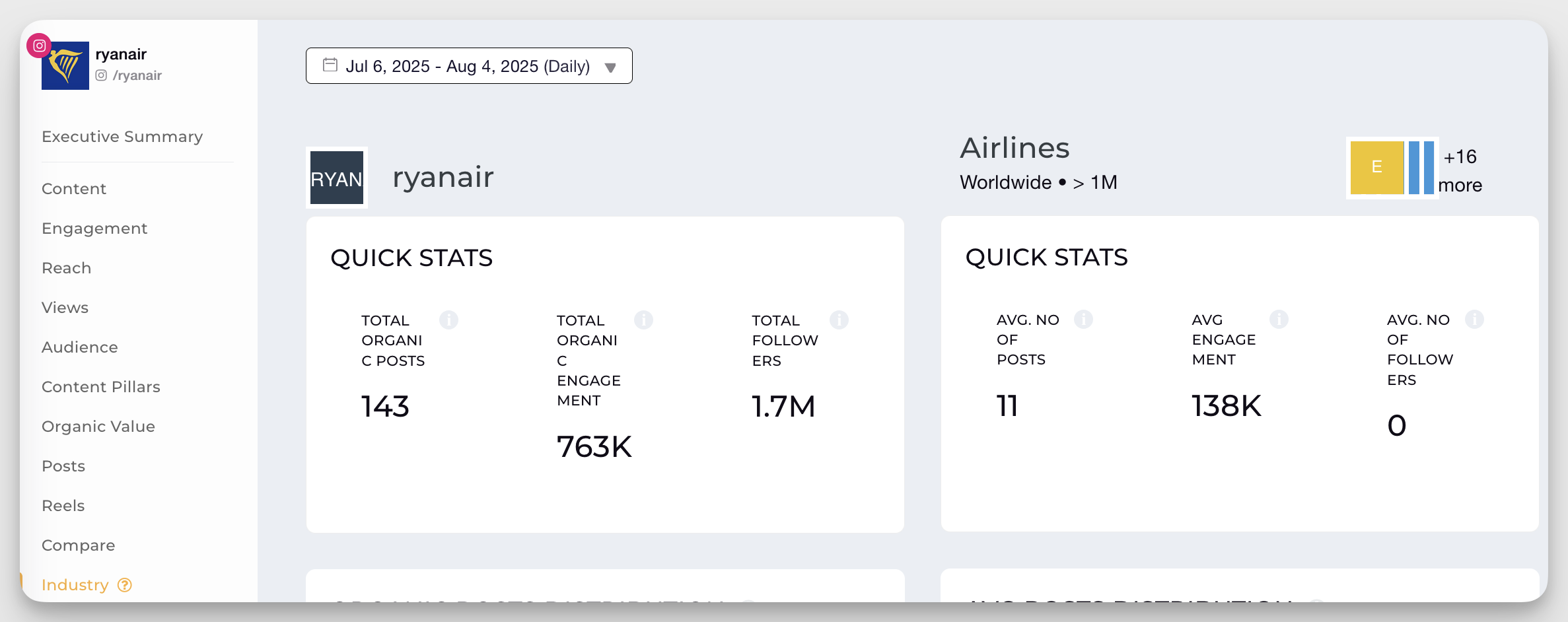
Brand perception metrics: understanding how you’re seen
Question to answer: “What do people really think about my brand?”
Brand perception is, as you can imagine, how a customer perceives a brand—how they judge, think, and feel about a brand and its products. Does your target customer have a favorable opinion of your brand?
When you have a clear understanding of your brand perception, you know how you need to position yourself in the market. This helps direct your strategy and your overall content to better grab your target audience.
10. Social Mentions: monitoring organic brand conversations
Social mentions occur when users reference your brand — by name, tag, or hashtag — in their posts, comments, or replies on social platforms. Unlike paid ads or branded posts, these mentions are organic signals of public interest.
They often represent:
- Real-time reactions to your products or services
- Unfiltered customer opinions, reviews, or feedback
- Earned media generated by users, creators, or media outlets
Because they come from your audience, not your brand, social mentions are a strong indicator of authentic engagement. Whether it’s praise, questions, or criticism, these mentions show what people really think — making them a powerful source of consumer insight.
When analyzing social mentions, it’s important to look at both quantity and quality:
- Mention volume tells you how often your brand is being talked about. A spike might signal a successful campaign — or a brewing crisis.
- Mention quality goes deeper, analyzing:
- Sentiment (positive, neutral, negative)
- Source credibility (is the mention from a top influencer or a spam account?)
- Context and intent (product praise, complaint, question, or joke?)
Relying on volume alone can be misleading. For example, 10,000 negative mentions after a product failure isn’t a success — but 500 positive mentions from respected voices in your niche can be incredibly valuable.
Social listening tools can help you monitor both how much and how well your brand is being talked about.
I always say you can’t manage what you don’t measure but just looking at numbers won’t tell the full story of how your brand is landing. I break brand performance down into two lanes in what I call my Q squared analysis which is using quantitative signals (the what) and qualitative signals (the why). - Jessica Mann, Brand Growth Strategist
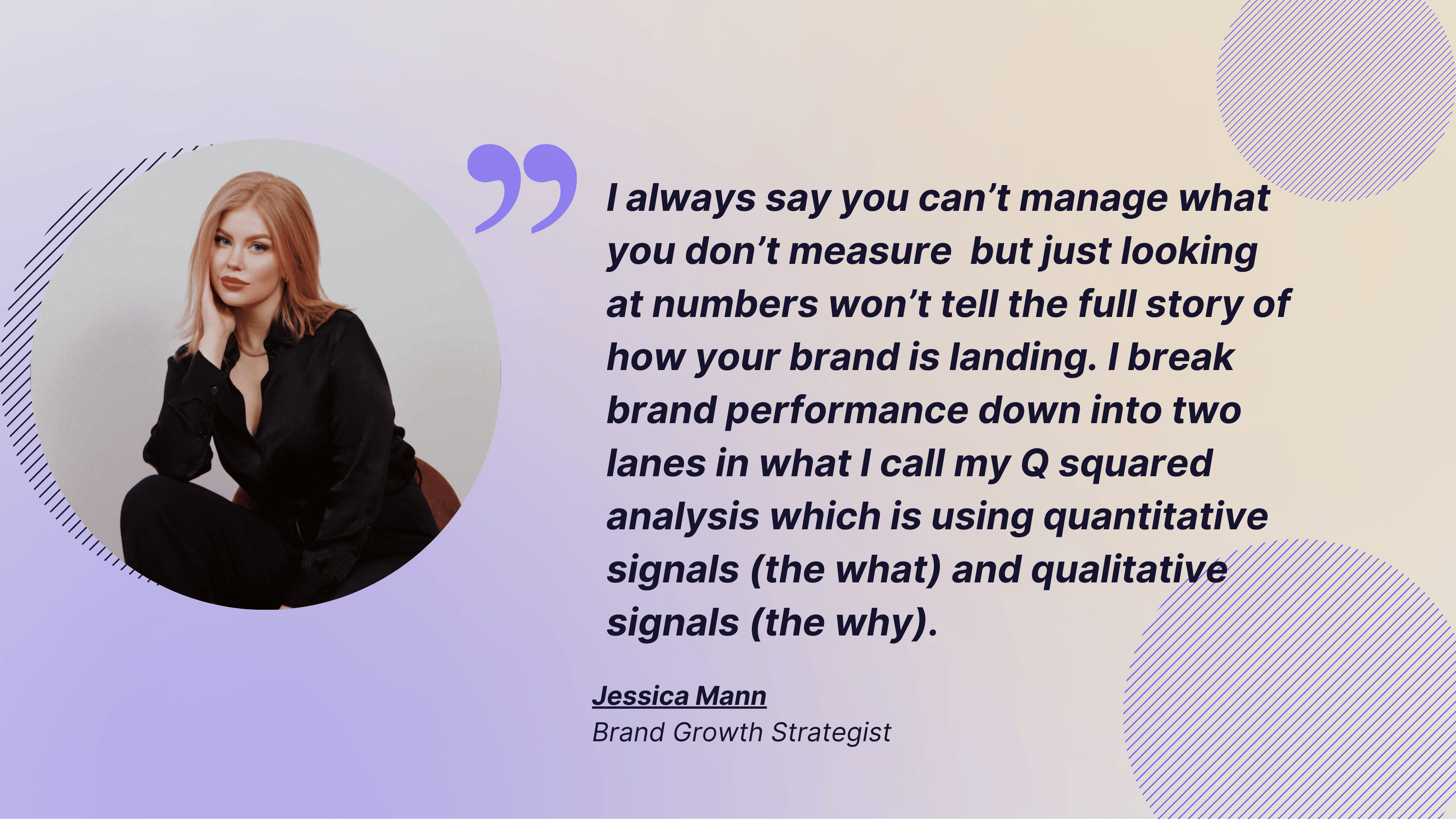
11. Brand Sentiment: measuring the emotional health of your brand
Brand sentiment is a metric that tells you how your target audience feels about your brand. Sentiment can be considered positive, negative, or simply neutral.
While you should always aim for positive brand sentiment, there’s usually nothing wrong with a neutral brand attitude. However, as I’m sure you understand, you want to avoid a negative brand sentiment.
On social, we're looking at engagement rate, shares, reposts and sentiment in comments. - Renée Shaw, Brand & Social Strategist
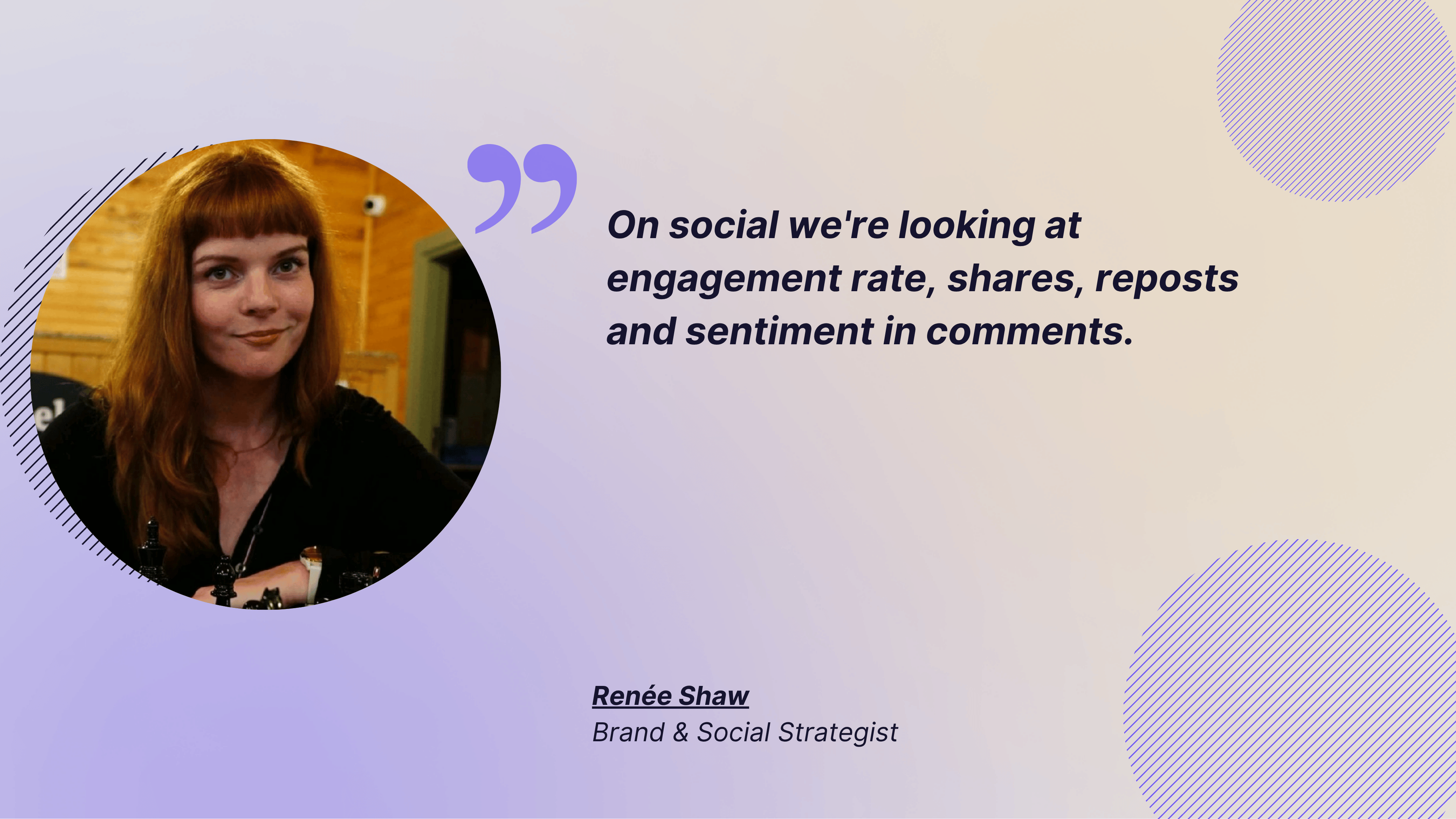
Measuring brand sentiment helps you get a better idea of whether your customers have a positive experience with your brand. If you’re discovering a more negative sentiment, you want to get hold of it early so that you can respond to the issues and create a better experience and attitude towards your brand.
Basic sentiment analysis classifies mentions as positive, neutral, or negative, but advanced sentiment tracking goes deeper:
- Emotion analysis: Identifies specific emotions like trust, frustration, admiration, or confusion
- Intent detection: Analyzes whether users are complimenting, complaining, asking for help, or considering a purchase
- Topic-level sentiment: Breaks down sentiment by product features, service experience, pricing, etc.
These insights help you understand why people feel the way they do, and what to fix or amplify in your brand strategy.
Customer reviews are powerful sentiment indicators and a goldmine for insights. Actively managing reviews across platforms like Google, G2, Yelp, or Trustpilot helps shift public sentiment over time and signals credibility to future buyers.
Final thoughts
Keeping track of your brand metrics ensures you always have a thumb on your brand’s overall health. If sentiment dips or perception isn’t high enough, you can create a campaign to change that. But you need the right tools to help, and Socialinsider is the perfect social media analysis tool for your needs. Get started today.
FAQS about brand metrics
1. What kind of metrics can help with brand performance measurement?
Metrics that can give you a better understanding of your brand performance include brand awareness, brand health, and brand perception.
2. How do you choose which brand metrics to track?
You can use the SMART framework to choose the best brand metrics for your team to track. This framework is outlined below:
- Strategic: Your metrics align with your marketing strategy and the business goals you’ve laid out.
- Market-driven: You look towards external metrics that let you know how your business is performing with your customers and against your competitors.
- Actionable: The metrics can be directly impacted by your actions.
- Repeatable: The metrics can be repeated in order to create patterns and trends to measure against.
- Touchpoints: Your metrics look towards customer touchpoints that give you an understanding of the customer experience.
If the metric hits each of those points from the SMART framework, it’s a good indicator that you should add it to your overall report.
3. How do you measure brand value?
Metrics like brand awareness, brand perception, and brand loyalty can give you a clear picture of your brand value.
4. What are the brand health metrics?
To gauge your brand health, look at metrics like:
- Customer Lifetime Value (CLV)
- Net Promoter Score (NPS)
- Customer Satisfaction Score (CSAT)
- Retention rate
5. What are the brand affinity metrics?
Brand affinity refers to how people feel about your brand. Essentially, brand affinity and brand sentiment are the same thing, so you’ll want to look towards your sentiment analysis and customer feedback.
Analyze your competitors in seconds
Track & analyze your competitors and get top social media metrics and more!
You might also like
Improve your social media strategy with Socialinsider!
Use in-depth data to measure your social accounts’ performance, analyze competitors, and gain insights to improve your strategy.




